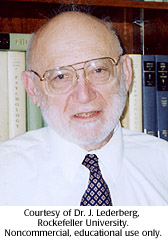Concept 18 Bacteria and viruses have DNA too.

 Joshua Lederberg discovered bacterial recombination and started a new field of research. Alfred Hershey was a phage geneticist who, with his research assistant, Martha Chase, did one of the most famous experiments in molecular biology. The "blender" experiment proved that DNA carried genetic information.
Joshua Lederberg discovered bacterial recombination and started a new field of research. Alfred Hershey was a phage geneticist who, with his research assistant, Martha Chase, did one of the most famous experiments in molecular biology. The "blender" experiment proved that DNA carried genetic information.
Joshua Lederberg (1925-2008)

Joshua Lederberg was born in Montclair, New Jersey, and as he said in a 1998 interview, he must have been born a scientist. Lederberg showed an early aptitude and interest in science. In 1941, after high school, he entered Columbia University with the intention of studying medicine.
At Columbia, Lederberg became interested in Beadle and Tatum's Neurospora experiments, which opened up new and exciting research possibilities especially in the fledgling field of genetic analysis. In 1943, Lederberg got a job as a media-prep gopher in Frances Ryan's lab in the Department of Zoology. Ryan was a post-doc at Stanford in 1941-42, where he met Beadle and Tatum and became interested in using Neurospora as a research model. Ryan's mentorship and discussions with other faculty members and graduate students, "nourished [Lederberg's] education as a scientist." Lederberg found that scientific research was more intellectually challenging than the textbook drills of medical school.
From 1943-1944, Lederberg had a year of active duty in the United States Naval Reserves where he worked in a clinical parasitology laboratory at the U. S. Naval Hospital on Long Island, New York. He did not see active service, and although he was expected to return to medical school, at the end of 1944 Lederberg was back working in Ryan's lab.
1944 was the year Oswald Avery and his group published their paper on the transforming ability of DNA. Lederberg was profoundly influenced by the paper and its unlimited implications. He and Ryan immediately tried doing similar experiments using Neurospora. Unfortunately, they were unable to get the necessary mutants. Lederberg started to think about using a bacterial system even though there was still debate about whether bacteria had genes or not.
An opportunity came to test his ideas. Edward Tatum was moving from Stanford to Yale to start a new microbiology lab. Ryan encouraged Lederberg to apply to work in Tatum's lab and Lederberg was accepted in 1946. Tatum already had some E. coli mutants that were suitable for the kind of experiment Lederberg outlined. Within six weeks, Lederberg had the results he needed to prove bacterial conjugation occurred. For this work, Lederberg shared the 1958 Nobel Prize in Physiology or Medicine with Edward Tatum and George Beadle.
After obtaining a Ph.D. from Yale in 1948, Lederberg accepted a job at the University of Wisconsin. It was at Wisconsin that Lederberg developed the technique of bacterial replica plating in which bacterial colonies can be duplicated onto filters for further analysis. Lederberg also helped create and later served as the chair of the Department of Medical Genetics.
In 1958, Lederberg left Wisconsin for the Department of Genetics at Stanford University's School of Medicine. At Stanford, in addition to his own bacterial research, Lederberg had two other interests. One was artificial intelligence; Lederberg helped develop one of the first computer systems (DENDRAL) that could make decisions using a specific set of algorithms and a database. Lederberg's other interest was exobiology. He was an active consultant on the Space Science Board of the National Academy of Sciences, and was greatly interested in the Mariner and Viking missions as well as the search for extraterrestial life.
In 1978, he was appointed President of Rockefeller University - the site of Oswald Avery's Pneumococcus research. From 1990, Lederberg was Professor Emeritus of Rockefeller University. He served on a number of government advisory boards and wrote a weekly column Science and Man for the Washington Post where he informed the public on issues in science and research. Lederberg's last project was to compile an informational web site at the National Library of Medicine using archival material he had accumulated over the years.


Joshua Lederberg was Edward Tatum's graduate student. Lederberg's wife Esther was George Beadle's graduate student.

Conjugation occurs only if bacteria are in close contact. Can you design an experiment that shows this is true?
 DNA and proteins are key molecules of the cell nucleus.
DNA and proteins are key molecules of the cell nucleus. One gene makes one protein.
One gene makes one protein. A gene is made of DNA.
A gene is made of DNA. Bacteria and viruses have DNA too.
Bacteria and viruses have DNA too. The DNA molecule is shaped like a twisted ladder.
The DNA molecule is shaped like a twisted ladder. A half DNA ladder is a template for copying the whole.
A half DNA ladder is a template for copying the whole. RNA is an intermediary between DNA and protein.
RNA is an intermediary between DNA and protein. DNA words are three letters long.
DNA words are three letters long. A gene is a discrete sequence of DNA nucleotides.
A gene is a discrete sequence of DNA nucleotides. The RNA message is sometimes edited.
The RNA message is sometimes edited. Some viruses store genetic information in RNA.
Some viruses store genetic information in RNA. RNA was the first genetic molecule.
RNA was the first genetic molecule. Mutations are changes in genetic information.
Mutations are changes in genetic information. Some types of mutations are automatically repaired.
Some types of mutations are automatically repaired.